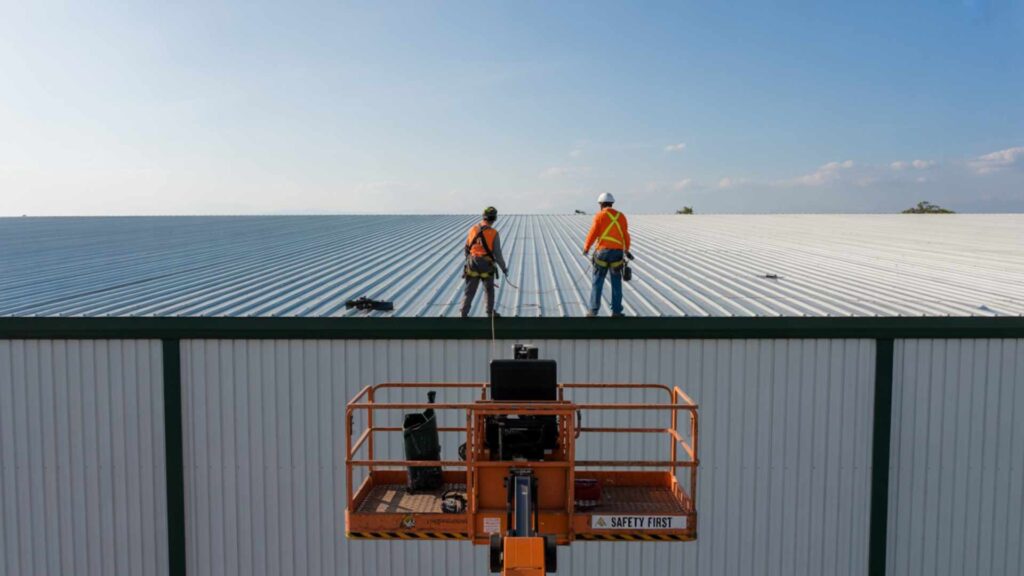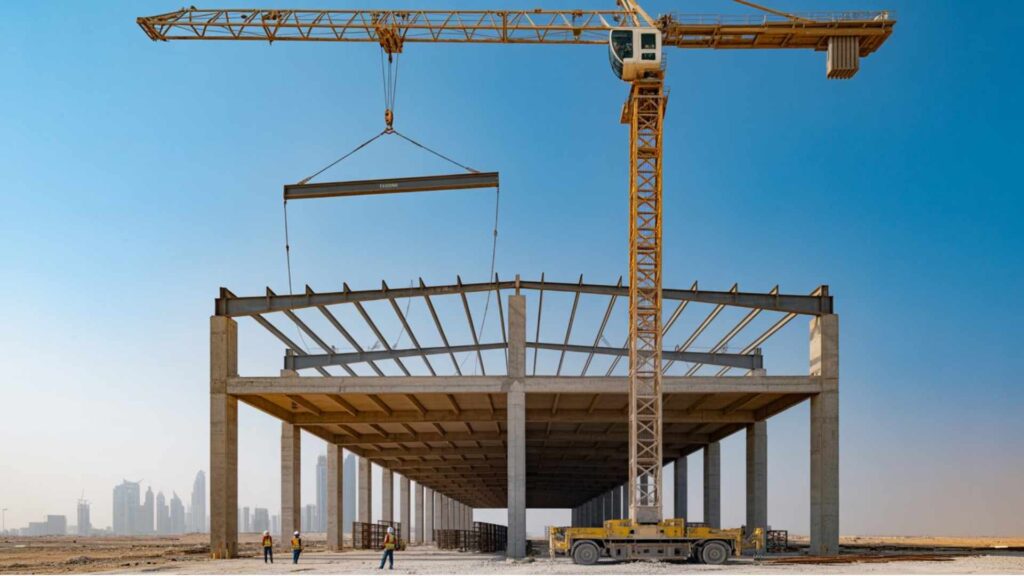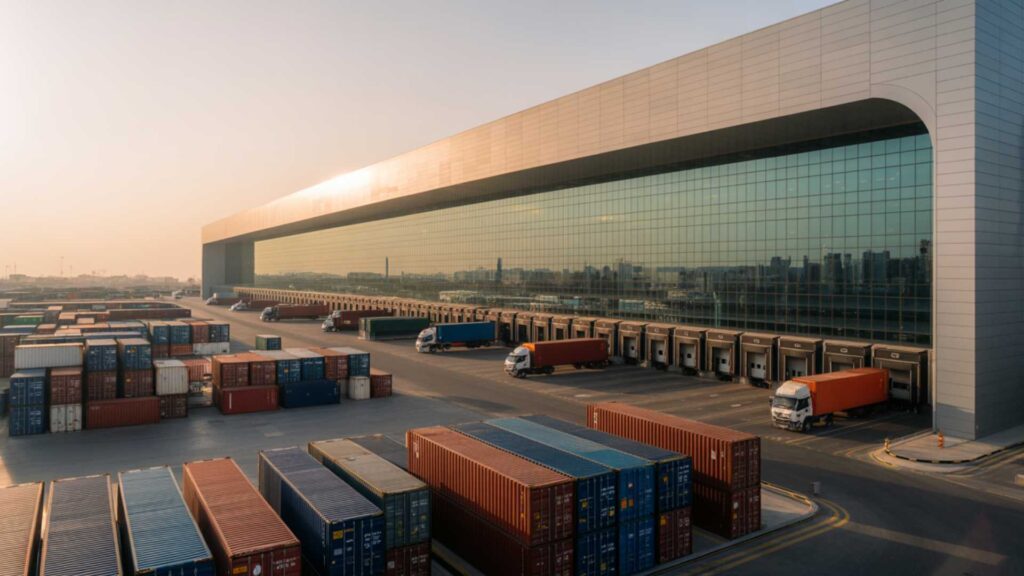For facility managers, maintenance of Warehouse Roofing is a critical part of operational continuity, not a periodic chore. It requires a structured approach grounded in routine inspections, material performance assessments, and preventive repair cycles.
This blog presents a detailed, actionable approach to maintaining warehouse roofs, suited for the specific demands of the UAE’s industrial environment.
Table of Contents
Types of Warehouse Roofing Systems in Dubai
In Dubai, warehouses may use different types of roofing systems depending on structural design, insulation needs, and operational load. Common warehouse roof types include:
- Corrugated metal roofing: Widely used for its durability and ease of installation
- Standing seam metal roofs: Favored for water-tightness and thermal expansion tolerance
- Built-up roofing (BUR): Layered systems are common in flat or low-slope warehouses
- Thermoplastic membranes (TPO/PVC): Used where heat reflectivity and chemical resistance are required
- Insulated sandwich panel roofs: Ideal for temperature-sensitive storage like cold chains
Each roofing type has specific maintenance requirements based on material behavior, joint design, and load-bearing structure.
Warehouse Roofing Maintenance Tips for Facility Managers in Dubai
Understand the Role of Roof Maintenance in Warehouse Operations
The roof of a warehouse is more than an architectural cap. It directly affects internal temperatures, energy efficiency, equipment protection, stock safety, and workplace compliance. Maintenance gaps can lead to:
- Water ingress and ceiling leakage
- Compromised insulation leading to higher HVAC loads
- Accelerated corrosion of MEP systems
- Mold growth and air quality issues
- Safety hazards for workers and stored materials
Facility managers must view roof maintenance as part of core operational planning, aligned with safety inspections and energy audits.
Set Up a Semi-Annual Inspection Protocol
Inspections form the foundation of preventive roof care. In Dubai’s climate, a minimum of two formal inspections per year is recommended, one before the summer peak (April–May) and one post-monsoon (September–October).
Key focus areas during inspections:
Surface Assessment
- Cracks, blisters, or delamination in membranes
- Signs of rust on metal sheeting or decking
- UV fading or chalking of coatings
- Debris accumulation, especially near vents and gutters
Structural and Joint Review
- Integrity of flashing, coping, and edge terminations
- Condition of expansion joints and movement points
- Displacement of fasteners, bolts, or panel overlaps
- Settling, ponding, or uneven surface gradients
Interior Indicators
- Water stains on ceilings or upper walls
- Unexplained drops in thermal performance
- Mold, damp odor, or condensation inside the facility
- Visible daylight through roof gaps or skylight borders
Facility teams should always try to use standardized inspection checklists and photo documentation to support repair tracking and reporting.
Keep Roof Surfaces and Drainage Paths Clear
Dust and sand are constant in Dubai and settle rapidly on roof surfaces. When combined with moisture from rainfall or condensation, this buildup becomes corrosive and adds load stress to the structure.
Cleaning Best Practices
- Use low-pressure water for washing metal or coated roofs
- Employ soft brooms or cloth mops for delicate materials like TPO or PVC
- Ensure gutters, scuppers, and downpipes are flushed thoroughly
- Inspect for nesting or blockage near HVAC units or skylights
Cleaning should be conducted quarterly and immediately after significant dust storms or rainfall events.
Address Thermal Expansion and Movement Fatigue
Thermal cycling is a serious stressor for warehouse roofing in the UAE. Daytime temperatures exceeding 45°C, followed by sharp night cooling, can cause material expansion and contraction, leading to joint failure or buckling.
Preventive Measures
- Apply high-flexibility sealants in areas subject to frequent movement
- Monitor expansion joints for cracking or separation
- Review insulation integrity beneath sheet metal or membrane roofs
- Avoid rigid attachments between dissimilar materials (e.g., metal to concrete)
Facility managers should engage roofing engineers to evaluate movement tolerance as part of long-term capital planning.
Recoat Protective Layers Based on Material Type and Exposure
Roof coatings degrade under UV, rainwater, and sand abrasion. In Dubai, the expected lifespan of a standard roof coating is significantly shorter than in temperate regions.
Coating Maintenance Guidelines
- Schedule reflectivity testing and coating adhesion checks every 3–5 years
- Recoat with elastomeric, polyurethane, or silicone systems based on substrate compatibility
- Focus on penetrations and perimeter flashing first, as they fail earlier
- Apply anti-dust and solar-reflective finishes for energy performance and surface longevity
Proper recoating reduces thermal transfer, supports insulation performance, and protects structural metal from oxidation.
Respond Promptly to Localized Damage
Even minor defects, such as a torn membrane corner or loose skylight flange, can lead to cascading failures under rain or wind load.
Common Repair Scenarios
- Sheet replacement for dented or rusted panels
- Fastener reseating and waterproofing
- Skylight perimeter resealing or panel substitution
- Flashing realignment and edge cap reinforcement
Repairs must be executed using compatible materials, matching fasteners, and certified workmanship to preserve warranties and structural ratings.
Monitor the Building Envelope from Within
While external inspections identify visible damage, interior monitoring offers early warnings of performance degradation.
Indicators to Track
- Temperature anomalies or HVAC load fluctuations
- Dampness or soft spots on insulation boards
- Pest activity linked to roof breaches
- Material discoloration near ceiling joints
Routine walkthroughs should include upper-floor assessments, ceiling scans, and sensor-based thermal imaging (where available).
Maintain Centralized Roofing Records
Long-term performance tracking is only possible through structured documentation. Facility managers should establish digital or physical logbooks with:
- Inspection dates, technician names, and detailed findings
- Maintenance actions performed with material specs and vendor details
- Coating and sealant lifecycle records
- Emergency repair events and incident reports
Well-documented roofing history is critical during insurance claims, warranty disputes, or future project tenders.
Plan for Lifecycle Costs and Long-Term Roofing Strategy
Warehouses have roofing systems with design lifespans ranging from 15 to 40 years. As materials age, maintenance frequency increases, and operational risk rises.
Strategic Planning Steps:
- Commission condition assessment reports every 5 years
- Develop budgets for re-roofing, coating upgrades, and insulation retrofits
- Align roof planning with MEP upgrades and solar installation schedules
- Choose service providers with documented regional experience and safety certifications
Facility managers should engage vendors who provide lifecycle forecasting and budget modeling, not just reactive repairs.
Leverage Maintenance Contracts for Consistency
Managing roofing systems internally may be viable for smaller facilities, but multi-warehouse or large-footprint operations require professional oversight. Contract-based maintenance provides schedule consistency, faster response times, and standardized reporting.
With Dura Altaj Contracting, facility managers gain access to:
- Safety-certified inspection teams with specialized access equipment
- Climate-adapted material selection and repair methods
- Emergency leak response protocols
- Asset tagging and condition tracking for long-term cost control
Contracting maintenance ensures the roof receives attention year-round, with issues addressed before they escalate.
Final Considerations
Warehouse roofing is exposed to some of the harshest physical conditions in Dubai. Its maintenance must be treated with the same seriousness as electrical safety, HVAC efficiency, and loading dock operations. A well-maintained roof safeguards inventory, reduces operational costs, and supports long-term facility planning.
For industrial warehouses, logistics hubs, or cold storage units, a proactive roof maintenance strategy is fundamental to operational integrity.
📞 Request a Site Evaluation with Dura Altaj Contracting LLC
We help facility managers implement structured roofing maintenance plans backed by civil engineering expertise and climate-tested solutions.
Contact us to schedule a roof assessment or discuss a preventive maintenance contract.



